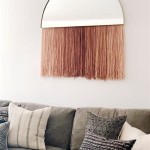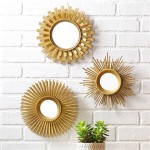Can You Keep A Mirror Outside? Considerations for Outdoor Mirror Placement
Mirrors, typically associated with interior decorating and personal grooming, can be intriguing additions to outdoor spaces. They possess the potential to enhance gardens, patios, and other exterior environments by creating illusions of depth, reflecting light, and adding aesthetic appeal. However, placing a mirror outdoors is not as straightforward as hanging one indoors. Several factors need careful consideration to ensure the mirror's longevity, safety, and overall effectiveness in its outdoor setting. These considerations range from the type of mirror used to its placement, securing mechanisms, and the environmental conditions it will endure.
The success of an outdoor mirror hinges on its ability to withstand the elements. Unlike indoor mirrors that are shielded from harsh weather, outdoor mirrors are exposed to rain, wind, sun, temperature fluctuations, and humidity. These environmental factors can degrade the mirror's reflective surface, corrode its backing, and weaken its frame. Therefore, selecting the right type of mirror and implementing proper protective measures are crucial for preserving its integrity and extending its lifespan.
Material and Construction Considerations
The choice of mirror material is paramount for outdoor use. Standard mirrors, often used indoors, are typically made with a thin layer of silver or aluminum applied to the back of a glass pane. This reflective layer is then protected by a coating, usually paint or a thin film. While adequate for indoor environments, these standard mirrors are susceptible to damage from moisture and temperature changes when exposed to the outdoors. The reflective layer can corrode, leading to black spots or a cloudy appearance that diminishes the mirror's reflectivity.
For outdoor use, acrylic mirrors or specially treated glass mirrors designed for exterior applications are preferable. Acrylic mirrors, also known as plastic mirrors, are significantly more durable and shatter-resistant than glass mirrors. They are less likely to break due to impacts or temperature stress, making them a safer option for outdoor environments, especially in areas with high winds or potential for accidental contact. While acrylic mirrors may not offer the same level of perfect clarity as glass, their durability and safety advantages often outweigh this minor aesthetic difference.
Glass mirrors intended for outdoor use typically undergo a specialized manufacturing process to enhance their resistance to environmental factors. This process may include using thicker glass, applying a more robust protective backing, and employing advanced sealing techniques to prevent moisture from penetrating the reflective layer. Some outdoor glass mirrors are also treated with UV-resistant coatings to protect them from sun damage, which can cause discoloration and fading. When selecting a glass mirror for outdoor use, it is essential to verify that it is explicitly designed and rated for exterior applications.
The framing material is another critical factor to consider. Wooden frames, while aesthetically pleasing, are prone to rotting, warping, and cracking when exposed to moisture and temperature changes. Metal frames, particularly steel, can rust if not properly treated. Ideal framing materials for outdoor mirrors include weather-resistant options such as aluminum, stainless steel, treated wood, or durable plastics. These materials can withstand the elements without significant degradation, helping to protect the mirror and prolong its lifespan.
Placement and Positioning Strategies
The placement of an outdoor mirror has a significant impact on its effectiveness and longevity. Strategic positioning can maximize the mirror's ability to enhance the outdoor space while minimizing its exposure to harsh environmental conditions. Direct sunlight, for instance, can overheat the mirror, causing it to expand and contract, potentially leading to cracks or distortions. Similarly, placing a mirror in a location that is constantly exposed to rain and wind can accelerate its degradation.
Consider placing the mirror in a sheltered location, such as under an overhang, on a covered patio, or against a wall that provides some protection from the elements. This will help to reduce its exposure to direct sunlight, rain, and wind. Orienting the mirror away from prevailing winds can also minimize the force exerted on it, reducing the risk of damage. Furthermore, think about the reflective properties of the mirror and how it will interact with the surrounding environment. Placing the mirror to reflect a particularly attractive feature, such as a garden, a water feature, or a scenic view, can significantly enhance the aesthetic appeal of the outdoor space.
Care should be taken to avoid positioning the mirror in a way that could create a safety hazard. For instance, placing a mirror near a walkway or driveway could reflect sunlight into the eyes of pedestrians or drivers, potentially causing temporary blindness or glare. Similarly, positioning a mirror where it reflects a busy street or intersection could be distracting and potentially dangerous. Careful consideration of the mirror's reflectivity and its potential impact on safety is essential before installation.
Securing and Maintenance Considerations
Properly securing an outdoor mirror is crucial for preventing accidents and ensuring its longevity. A mirror that is not securely fastened can be blown down by the wind, causing damage to itself, surrounding objects, or even injury to people. Selecting appropriate mounting hardware and installation techniques is essential for ensuring that the mirror remains securely in place, even in adverse weather conditions.
For wall-mounted mirrors, use heavy-duty brackets or screws that are designed for outdoor use. Ensure that the mounting surface is strong and stable enough to support the weight of the mirror. If mounting the mirror to a wooden fence or structure, use screws that are long enough to penetrate the wood deeply and provide a secure hold. For heavier mirrors, consider using multiple mounting points to distribute the weight evenly. Checking the stability of the mounting hardware periodically is recommended, particularly after periods of strong wind or heavy rain.
Mirrors can also be mounted on freestanding frames or stands, which can be placed directly on the ground or secured to a patio or deck. When using a freestanding frame, ensure that it is stable and resistant to tipping over. Consider adding weights or anchors to the base of the frame to provide additional stability. Regular maintenance is essential for preserving the appearance and integrity of an outdoor mirror. Cleaning the mirror regularly with a mild detergent and water can remove dirt, grime, and other debris that can accumulate on the surface. Avoid using abrasive cleaners or harsh chemicals, as these can damage the reflective layer or the frame.
Inspecting the mirror and its frame periodically for signs of damage is also recommended. Look for cracks, chips, or discoloration in the mirror, as well as rust, rot, or warping in the frame. Addressing any damage promptly can help to prevent it from escalating and potentially prolong the life of the mirror. In cold climates, consider taking extra precautions to protect the mirror during the winter months. If possible, remove the mirror and store it indoors during periods of extreme cold or snowfall. If removing the mirror is not feasible, cover it with a protective tarp or blanket to shield it from the elements. This can help to prevent the glass from cracking due to temperature fluctuations and reduce the risk of damage from ice or snow.

Garden Mirrors In Winter Can You Leave Them Outside Soraya Interiors

Garden Mirrors In Winter Can You Leave Them Outside Soraya Interiors

Improving Natural Light Access Sustainable Living Stack Exchange

Outside Mirror Selfie The Newest Trend Taking Over Instagram

Adjust Your Car Mirrors Properly To Avoid Accidents

How To Keep Your Car Mirrors From Fogging Up Motor Hills

How To Adjust Your Car Mirrors Eliminate Blind Spots The Art Of Manliness

Outside Mirror Selfie The Newest Trend Taking Over Instagram

15 Garden Mirror Ideas For Backyards Empress Of Dirt

Mirror Window Adhesive One Way Anti Ping Effect For Heat Paper







